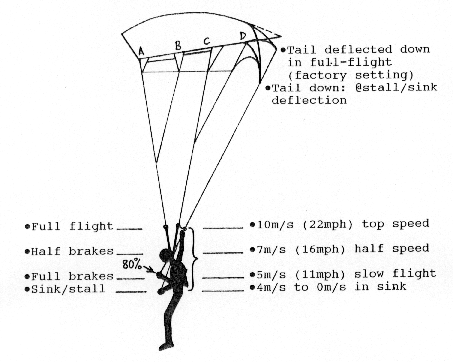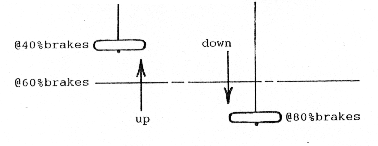| Control Response
The Classic has conventional 2x2 suspension geometry.
Lines from the front risers cascade to the A & B attach
points. Lines from the rear risers cascade to the C &
D attach points. The weight is distributed approximately 60%
on the front risers, and 40% on the rear risers.
The Classic has excellent rear riser flare capability,
and if you pull down one front riser, a really good diving
spiral (good to separate the stack on team accuracy jumps).
A front riser "spiral line" has been provided to make front
riser spirals easier. The line goes from the right front riser
to just below the outside right A/B cascade point. By pulling
in on this line (about three feet), you can achieve a really
effective diving spiral. Complete all spirals above a "hard
floor" of 1000 feet above the ground, to be safe!
With a thick airfoil, the Classic has a long control range.
That means from full flight (with no tension from the tail
on the steering lines) to the stall requires a control stroke
that exceeds the arm length of most jumpers. Most accuracy
jumpers prefer their canopy enter full sink/stall with their
hands just at, or slightly below, waist level. This means
the forearms are horizontal, or depressed slightly below horizontal,
as the canopy goes into a sink.
To achieve this setting, the tail of your canopy will have
to be pulled down slightly while in full flight (see figure
1). The mark (made at the factory) on the lower control line
is an approximate setting which you may have to adjust up
or down a few inches to achieve sink/stall at the desired
point.
With the sink/stall point at this setting, you must use
extreme caution to not abruptly stall the canopy at low altitude!
A waist high stall point allows experienced accuracy jumpers
to "finesse" entry into sink and control their glidepath as
they finish their approach. It gives experienced accuracy
jumpers a last ditch "salvage" ability if they find themselves
going over the top of the pad because they have 12 to 18 inches
of control stroke downward, below the steady state sink/stall
entry point.
Do not stall or sink your Classic below 500
feet unless you have at least 100 jumps on the canopy,
and are comfortable in this control regime! Even then, do
not stall or sink your canopy below 500 feet unless you are
below 50 feet, and your glidepath will positively end with
an impact centered on a foam landing mat or soft pea gravel
pit. A low altitude stall and/or rock back could
cause you serious bodily injury or even death.
Steering: The Classic has moderate steering forces.
You'll find that turns above 1/2 brakes require six to twelve
inches of toggle deflection, and should be made with smooth
but positive movements Below 1/2 brakes, as the wingtips fill
out, you will find that steering is more precise, and that
a "cross control" turn is most effective Instead of simply
pushing down on the desired turn side toggle, let up on the
"outside" toggle in equal measure, for a flat, responsive
turn (See figure 2 below)
Figure 1 - Control Range

Figure 2 - Cross Control Steering

|